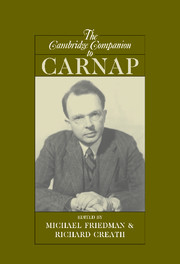Book contents
- Frontmatter
- Introduction: Carnap’s revolution in philosophy
- 1 Carnap’s intellectual development
- 2 Geometrical leitmotifs in Carnap’s early philosophy
- 3 Carnap and Frege
- 4 Carnap and Husserl
- 5 Carnap, Russell, and the external world
- 6 The Aufbau and the rejection of metaphysics
- 7 Carnap and the Vienna Circle: rational reconstructionism refined
- 8 Carnap and modern logic
- 9 Tolerance and logicism: logical syntax and the philosophy of mathematics
- 10 Carnap’s quest for analyticity: the Studies in Semantics
- 11 Carnap on the rational reconstruction of scientific theories
- 12 Carnap on probability and induction
- 13 Carnapian pragmatism
- 14 Quine’s challenge to Carnap
- Bibliography
- Index
7 - Carnap and the Vienna Circle: rational reconstructionism refined
Published online by Cambridge University Press: 28 April 2008
- Frontmatter
- Introduction: Carnap’s revolution in philosophy
- 1 Carnap’s intellectual development
- 2 Geometrical leitmotifs in Carnap’s early philosophy
- 3 Carnap and Frege
- 4 Carnap and Husserl
- 5 Carnap, Russell, and the external world
- 6 The Aufbau and the rejection of metaphysics
- 7 Carnap and the Vienna Circle: rational reconstructionism refined
- 8 Carnap and modern logic
- 9 Tolerance and logicism: logical syntax and the philosophy of mathematics
- 10 Carnap’s quest for analyticity: the Studies in Semantics
- 11 Carnap on the rational reconstruction of scientific theories
- 12 Carnap on probability and induction
- 13 Carnapian pragmatism
- 14 Quine’s challenge to Carnap
- Bibliography
- Index
Summary
INTRODUCTION
Rudolf Carnap is today the best known representative of the Vienna Circle, even though he was neither its nominal leader (Moritz Schlick), nor its effective founder (Hans Hahn), nor its most prolific writer and propagandist (Otto Neurath). The reason for Carnap's prominence lies in two books - The Logical Construction of the World (1928, better known as the Aufbau) and The Logical Syntax of Language (1934c, translated in 1937) - and a series of papers - including “The Elimination of Metaphysics Through Logical Analysis of Language” (1932d/1959) and “The Physical Language as the Universal Language of Science” (1932a, translated as The Unity of Science, 1934) - published between 1928 and 1936. In these works Carnap managed to articulate with until then unsurpassed clarity certain theses of extreme boldness and daring complexity that were closely associated with the Circle as a whole. Yet while he provided exemplary articulations of its members' characteristic convictions and also set themes for the Circle's continuing discussions, it must be stressed that the development of these theses was very much Carnap's own and that many of his positions encountered opposition even within the Circle itself. If one is then moved to add that there is more to the Vienna Circle's philosophy than Carnap's, one must also add that there is more to Rudolf Carnap than the Vienna Circle's influence.
- Type
- Chapter
- Information
- The Cambridge Companion to Carnap , pp. 153 - 175Publisher: Cambridge University PressPrint publication year: 2007
- 3
- Cited by



